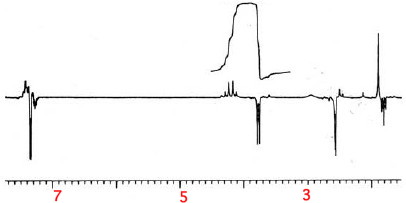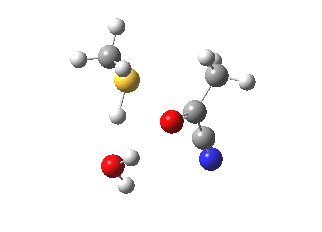The tetrahedral intermediate is one of those iconic species on which the foundation of reaction mechanism in organic chemistry is built. It refers to a (normally undetected and hence merely inferred) species formed initially when a nucleophilic reagent attacks a carbonyl compound. Its importance to understanding the activity of enzymes cannot be overstated. An example of this genre is shown below, in which a thiol reacts with an acyl cyanide to form the species ringed in green.
The lifetime of such a species is normally assumed to be too short for it to be detectable[cite]10.1021/jo00389a050[/cite], but suitable adjustment of the substituents enables its lifetime can be extended to many hours. Thus the reaction between PhCH2SH (benzyl thiol) and acetyl cyanide occurs slowly and the resulting intermediate is stable enough to be detected by 1H NMR spectroscopy[cite]10.1021/ed064p725[/cite]. The spectrum in CDCl3 is shown below:
What is shown is actually a difference spectrum, in which the spectrum measured immediately after mixing the two reagents is subtracted from that obtained after about 12 hours. The negative peaks represent a species which is being replaced by one giving rise to positive peaks. It is the nature of these latter peaks which directly prove that the species formed after 12 hours contains an asymmetric tetrahedral carbon atom.
- The negative peaks are ~δ1.8ppm (triplet), 3.8 (doublet [assigned to the CH2SH region], 2.6 ppm (the Me group of the acetyl cyanide) and 7.3 (the Ph group).
- The positive peaks are 1.9 ppm (Me singlet), an AB quartet at 4.2 ppm equal in integration to the negative peak at 3.8 ppm, and a more disperse Ph peak.
- If pressure is applied[cite]10.1039/P29870001477[/cite] to the solution, the tetrahedral intermediate forms more quickly, and actually crystallises out of solution (Le Chatelier’s principle).
- If a hydroxylamine (RNHOH) is used instead of a thiol, the tetrahedral intermediate forms much more quickly[cite]10.1021/jo00389a050[/cite], and both N: and O: nucleophilic isomers can be detected[cite]10.1021/jo00389a050[/cite] (by 15N-13C 2J couplings in the case of the former).
- Particularly significant is that the new product manifests its CH2 group as an AB quartet. This must mean that the two methylene protons are diastereotopic (have different chemical shifts and hence the coupling between them can be observed). This cannot be achieved by restricted rotation (atropisomerism) and hence can only arise by the CH2 group being close to an asymmetric (chiral) carbon atom bearing four different groups.
The slow motion capture of a tetrahedral intermediate using substituents finely tuned for the purpose (a relatively non nucleophilic thiol coupled with a relatively poor cyano leaving group) enables us to directly prove its identity using NMR. The same technique as it happens was also used to characterise another iconic intermediate, the carbocation, many years after it too was inferred as a key mechanistic participant.
Tags: diastereotopic, spectroscopy, tetrahedral intermediate


[…] Secrets of a university tutor: tetrahedral intermediates. […]